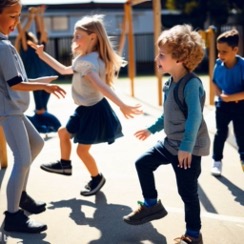As kids actively participate in sports, recreational activities, and daily play, the risk of head injuries, including concussions, becomes a concern for parents, coaches, and educators. Concussions are mild traumatic brain injuries that require special attention, particularly when it comes to children, whose developing brains are more vulnerable to the effects of such injuries. In this blog post, we will delve into the world of concussions in kids exploring the importance of recognition, treatment, and proactive measures to protect young brains.
1. Understanding Concussions in Kids
A concussion occurs when a sudden impact to the head or a significant jolt to the body causes the brain to undergo rotational forces cause shear in the axons that disrupt function. In children, whose brains are still developing, concussions can have unique implications and may require different management strategies than those used for adults. The signs and symptoms of concussions in kids might differ from those in adults, making it vital for parents, teachers, and coaches to be aware of the warning signs.
2. Recognizing the Signs and Symptoms
Recognizing the signs of a concussion in children can be challenging, as kids might not always communicate their symptoms clearly. Common signs include headache, dizziness, nausea, confusion, sensitivity to light and noise, changes in mood or behavior, and difficulty with balance and coordination. It is crucial for adults to observe any unusual behavior or physical changes in a child after a fall, collision, or impact to the head.
3. Importance of Immediate Action
If a concussion is suspected, it is essential to take immediate action to ensure the child’s safety and well-being. The “when in doubt, sit them out” approach should be followed, removing the child from play or activity immediately and seeking medical attention. Resting the brain after a concussion is crucial for proper healing and to prevent further injury.
4. The Role of Healthcare Professionals
Healthcare professionals, particularly those experienced in pediatric concussions, play a crucial role in assessing and managing concussions in kids. A thorough evaluation by a qualified healthcare provider is essential to determine the severity of the injury and to create an appropriate recovery plan. Parents should seek medical attention promptly, even if symptoms appear mild, to avoid any potential complications.
5. Cognitive Rest and Gradual Return to Activity
Following a concussion diagnosis, cognitive rest is vital for the child’s recovery. This includes limiting activities that strain the brain, such as reading, using screens, or engaging in mentally demanding tasks. As the child’s symptoms improve, a gradual return-to-activity plan can be implemented, under the guidance of a healthcare professional. This stepwise approach allows the child’s brain to heal gradually and safely resume normal activities.
6. Concussion Prevention Strategies
Prevention is always the best approach when it comes to head injuries in children. Implementing concussion prevention strategies can significantly reduce the risk of concussions during play and sports activities. Some preventive measures include:
a. Proper Use of Safety Equipment: Ensure children wear appropriate helmets and safety gear while engaging in sports or activities with a risk of head injury.
b. Supervision and Adult Presence: Adult supervision is essential during play to prevent risky behavior or dangerous activities that could lead to head injuries.
c. Rule Enforcement: Coaches and educators must enforce rules that prioritize player safety and discourage aggressive play that could result in head impacts.
d. Educating Parents, Coaches, and Teachers: Raising awareness about concussions, their signs, and the importance of seeking medical attention is crucial for early detection and treatment.
7. Fostering a Supportive Environment
After a child sustains a concussion, it is vital to foster a supportive environment that emphasizes patience and understanding during their recovery. Parents, teachers, and coaches should communicate openly with the child, answering their questions and concerns, and providing emotional support throughout the healing process.
Concussions in kids are a serious concern that requires vigilance, recognition, and proactive measures from parents, teachers, coaches, and healthcare professionals. Early detection, proper medical evaluation, and cognitive rest are crucial for the child’s recovery. Equally important is the emphasis on concussion prevention, ensuring that children can engage in sports and recreational activities safely. By working together and prioritizing the well-being of our young athletes and children, we can create a safer environment that fosters their growth, development, and enjoyment of physical activities without compromising their health.
